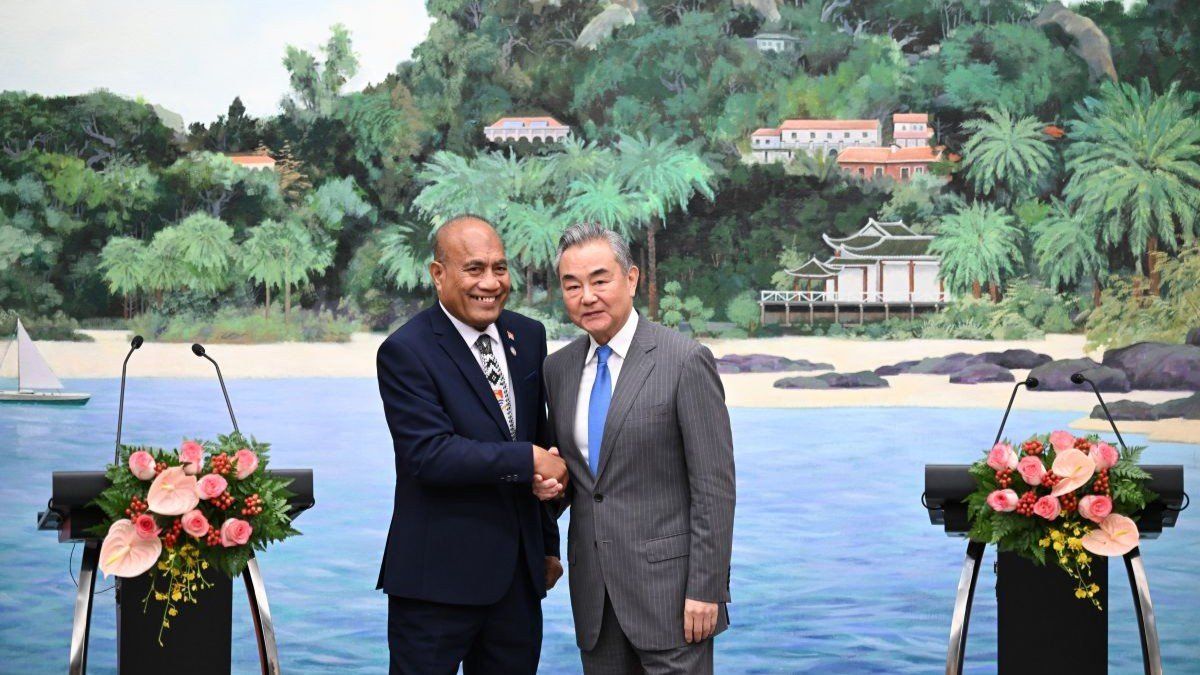Last week, something highly unusual was spotted off the coast of Japan. In an unprecedented show of naval power, two Chinese aircraft carriers were seen cruising together near the country’s easternmost islands of Minamitori and Okinotori—far out into the Pacific Ocean.
The carrier groups conducted drills alongside one another for the first time in Pacific waters, accompanied by jets, helicopters, and supporting warships.
The operations underscore Beijing’s growing bid for influence in the Pacific, and experts say they are part of a broader strategy that extends far beyond China’s immediate neighbors.
Less than two weeks ago, China’s foreign minister Wang Yi hosted senior diplomats from 11 Pacific Island nations in the southern city of Xiamen, where he pledged $2 million to support infrastructure building and climate adaptation efforts in the region.
The Pacific Islands are a valuable prize on the geopolitical chessboard – around a dozen nations comprising thousands of islands and atolls stretching more than 7,000 miles east of Australia.
“All of the Pacific Island region weighs into China's kind of broader strategy,” says Kathryn Paik, former director of Southeast Asia and the Pacific on the US National Security Council, who is now at the Center for Strategic and International Studies.
China has stepped up its engagement in the region in recent months—a trend underscored by its navy ships making an unprecedented voyage around Australia and carrying out live-fire exercises off the coast of Sydney earlier this year.
What’s motivating China’s drive into the Pacific? Closer ties with Pacific Island nations could boost China’s influence in international bodies like the UN, and they could also give Beijing preferential access to vast territorial waters containing mineral wealth and fish stocks.
But beyond those diplomatic and economic gains, there is a bigger goal as well, says Rory Medcalf, Head of the National Security College at Australia National University. Dominating the Pacific with naval power could increase China’s ability to “knock the United States out of a future war in the region.”
Once a key battleground in World War Two, the Pacific Islands now lie at the center of Beijing’s broader Indo-Pacific security strategy. From the Solomon Islands to Kiribati, China has made repeated attempts to leverage its development projects to gain access to strategic ports and airfields—with the PLA’s newest destroyer docking in Vanuatu’s Port Vila late last year.
“Any Chinese presence there would significantly complicate the US and Australian calculus when it comes to any contingency in either the South China Sea or Taiwan,” says Paik. “If they were to actually be able to build out a port in Solomon Island, similar to what they did in Cambodia, that would be just like a game changer for the US, Australia and others.”
What do the Pacific Islands want? Pacific Island countries face a multitude of development challenges stemming from geographic isolation and the impacts of climate change, to a growing flight of skilled workers. With a quarter of Pacific Islanders struggling below the poverty line—regional leaders will be turning to any and all partners capable of providing meaningful support.
“They want development assistance. They want economic growth. They want to protect their natural resources,” says Medcalf. “A lot of the development assistance China has provided has been effectively building grand infrastructure to satisfy the political needs of the government.”
China has ramped up its development assistance in recent decades, positioning itself as one of the largest aid providers in the region. Between 2008 and 2022, China committed $10.6 billion to various projects in the region, ranging from building transport infrastructure and government buildings, to supporting healthcare and education initiatives.
But China is still the challenger in a historically Western-aligned region. Australia remains by far the Pacific’s leading development partner, committing $20.6 billion over the same period. And other Western-aligned countries are active as well.
“It’s a permanent contest, with other players—not only the United States, but Australia, Japan, New Zealand, and, to some extent, the Europeans as well,” says Medcalf.
Together these countries have provided alternatives to Chinese assistance, with the QUAD countries—Australia, India, Japan, and the United States—announcing a range of multilateral initiatives to boost engagement in the region in 2023.
Beyond this,Pacific Island leaders and their constituents are skeptical about China’s growing security involvement and influence in local government. In 2021, the Solomon Islands’ decision to switch diplomatic recognition from Taiwan to China triggered nationwide anti-government protests, with rioters torching businesses in Honiara’s Chinatown.
“One of the biggest challenges for China is that the region certainly does prefer and is more just aligned culturally and historically with traditional western partners,” Paik says. “There's a lot of unsettlement about where the money's going, why the decisions are made, of certain types of infrastructure, of the governing of the government.”
Still the advantage the US and its allies currently hold over China relies on them “staying on the ball” in the region—an approach that analysts say the Trump administration has deprioritized. The US’ cuts to USAID programs, tariffs, and withdrawal from the Paris Climate Agreement and World Health Organization have opened the door for China to expand its influence in the region.
Last Wednesday, alarm bells rang in Canberra and London after the Pentagon announced that it was reassessing the AUKUS security pact, a multibillion dollar deal to counter Chinese influence by equipping Australia with a nuclear powered submarine fleet.
But while the geopolitical tides continue to pull the Pacific Island nations in different directions, their people are often focused on more immediate problems.
“We've actually got every chance of holding the line [against China], and most importantly, we've got to do it in a way that's respectful of the priorities of Pacific Island countries, because their priority is their own development,” says Medcalf.
